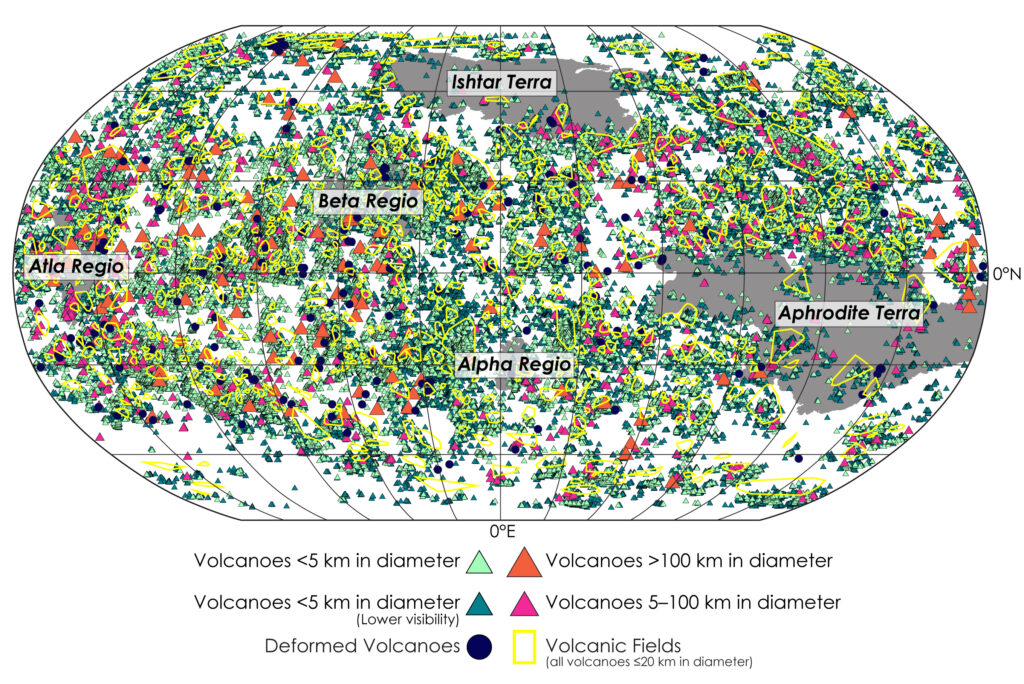2023-03-29 ワシントン大学セントルイス校
 A new paper in JGR Planets provides the most comprehensive map of all volcanic edifices on Venus ever compiled. (Map created by Rebecca Hahn, Washington University in St. Louis)
A new paper in JGR Planets provides the most comprehensive map of all volcanic edifices on Venus ever compiled. (Map created by Rebecca Hahn, Washington University in St. Louis)
この地図は、NASAのマゼラン探査で得られたレーダー画像を使用して作成されました。
この地図は、火山が集中している場所、火山の数、大きさなどを把握するための貴重なデータベースを提供し、将来的には活動中の溶岩流を予測するために役立つことが期待されます。
この地図は、まだ多くの未知の火山が海底に潜んでいるということを考えると、非常に貴重なものとなります。
<関連情報>
- https://source.wustl.edu/2023/03/scientists-share-comprehensive-map-of-volcanoes-on-venus-all-85000-of-them/
- https://agupubs.onlinelibrary.wiley.com/doi/10.1029/2023JE007753
金星の火山の形態的・空間的解析 A Morphological and Spatial Analysis of Volcanoes on Venus
Rebecca M. Hahn, Paul K. Byrne
Journal of Geophysical Research: Planets Published: 24 March 2023
DOI:https://doi.org/10.1029/2023JE007753
Abstract
Venus is home to many thousands of volcanic landforms that range in size from much less than 5 km to well over 100 km in diameter. Volcanism is clearly a major, widespread process on Venus, and is a principle expression of the planet’s secular loss of interior heat. Without sufficient in situ data to clearly determine its internal structure, we can use the morphological and spatial characteristics of volcanoes across the planet to help place constraints on our understanding of the volcanic characteristics and history of Venus. With the Magellan SAR (synthetic-aperture radar) FMAP (full-resolution radar map) left- and right-look global mosaics at 75 meter-per-pixel resolution, we developed a global catalog of volcanoes on Venus that contains ∼85,000 edifices, ∼99% of which are <5 km in diameter. We find that Venus hosts far more volcanoes than previously mapped, and that although they are distributed across virtually the entire planet, size–frequency distribution analysis reveals a relative lack of edifices in the 20–100 km diameter range, which could be related to magma availability and eruption rate. Through spatial density analysis of volcanoes alongside assessments of geophysical datasets and proximal tectonic and volcanic structures, we report on the morphological and spatial patterns of volcanism on Venus to help gain new insights into the planet’s geological evolution.
Key Points
- We present a new global catalog of volcanoes on Venus that includes ∼85,000 edifices, ∼99% of which are <5 km in diameter
- We developed an automated approach to delineating volcanic fields—high spatial concentrations of small volcanoes—from our catalog
- There is a lack of edifices in the 20–100 km dimeter range on Venus
Plain Language Summary
There are many thousands of volcanoes on the surface of Venus. These volcanoes provide clues into the interior properties of the planet, properties that are otherwise largely inaccessible to us at present. We used the Magellan synthetic aperture radar (SAR) imagery to catalog volcanoes across Venus at a global scale. Our resulting database contains ∼85,000 volcanoes, ∼99% of which are less than 5 km in diameter. Although there are volcanoes across almost the entire surface of the planet, there seems to be relatively fewer volcanoes in the 20–100 km diameter range, which may be a function of magma availability and eruption rate. Patterns in spatial clustering of volcanoes in conjunction with geophysical datasets and proximal tectonic and volcanic structures can reveal the nature and distribution of volcanic landforms on Venus.
This article is protected by copyright. All rights reserved.



